Seasons – Summer 2016
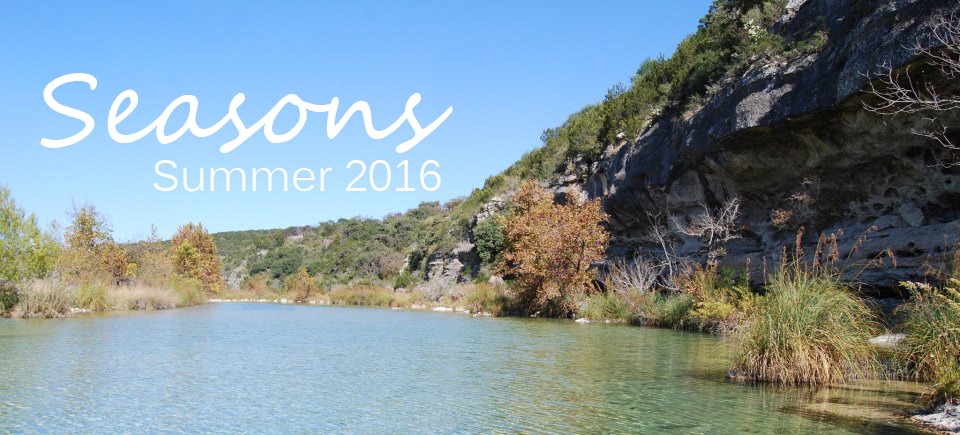
From the Plateau Land & Wildlife Management Team,
While spring was kind with cool temperatures and plenty of rainfall, summer is here and leaving its mark with sunshine and heat. And although this summer is expected to be cooler and wetter than usual, we know it won’t be a true Texas summer without plenty of dry, hot days. As we prepare for the heat wave, we must keep in mind how summer can affect our land and the wildlife. With the extra rain we’ve been getting, now is the perfect time to consider installing a water table for the drier months to come.
Today we celebrate the summer solstice- when the sun reaches its farthest point north of the equator and provides us with the longest day of the year. We hope you take some of these extra daylight hours to read through this issue of Seasons which is full of educational information written by our in-house team. This issue makes for a perfect poolside, lakeside or indoor read. We’ll cover the various wildlife management activities perfect for the summer months, Biologist James Hall tells us about his time at the James G. Teer Conservation Leadership Institute, Tech Damon Speidel recounts an entertaining and unforgettable fishing excursion and Biologist Sarah Kalich discusses bees and pesticides.
We hope you enjoy this issue of Seasons and everything this summer has to offer. As always, if there is any way Plateau can help you protect, enhance or better enjoy your land during this special season, just give us a call. We’ll be here when you need us.
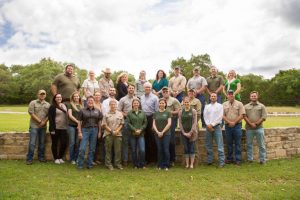 Until next season and Seasons,
Until next season and Seasons,
The Plateau Team
Table of Contents
The James G. Teer Conservation Leadership Institute
Summer Wildlife Management Activities Checklist
Big Fish
Native Bees and Organic Pesticides
Plateau Summer Webinar Series
Ground Water
Plateau Land Group Featured Listing
The James G. Teer Conservation Leadership Institute
By James Hall, Plateau Staff Biologist II
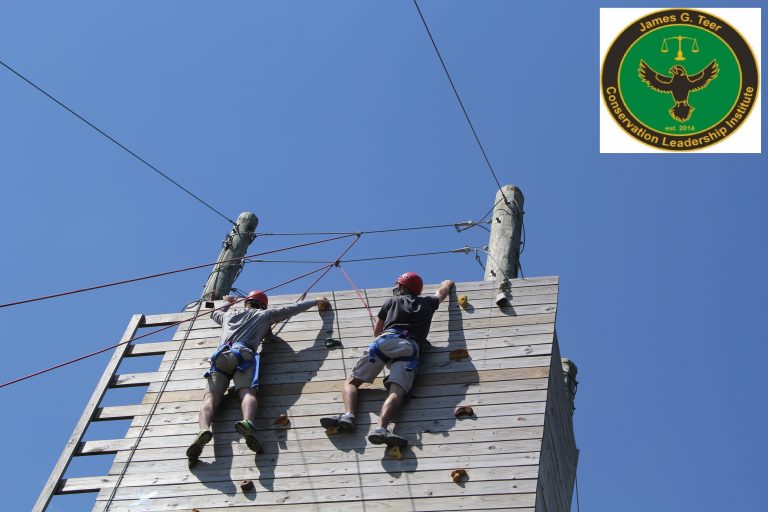 My grasp began to slip as I started sweating and I knew my toehold was not going to last when my left leg began trembling slightly. My climbing partner, Andy, could see my next handhold and described its location – just beyond my reach. Andy and I were tasked with making it to the top of the 40-foot wall while carrying a small basketball. Only one of us could climb while the other held the ball, but we both needed to summit with ball in hand to “win.” We were near the 30 ft mark and I knew if I didn’t jump for the grip soon, I might slip and fall for lack of a decent position.
My grasp began to slip as I started sweating and I knew my toehold was not going to last when my left leg began trembling slightly. My climbing partner, Andy, could see my next handhold and described its location – just beyond my reach. Andy and I were tasked with making it to the top of the 40-foot wall while carrying a small basketball. Only one of us could climb while the other held the ball, but we both needed to summit with ball in hand to “win.” We were near the 30 ft mark and I knew if I didn’t jump for the grip soon, I might slip and fall for lack of a decent position.
I used to enjoy climbing, I thought. Evidently, fear of heights and potential injury is a rationality that comes with age. I could now see the handhold Andy mentioned, a small green piece of plastic shaped like a crescent moon. I braced my legs and leapt, and with my right hand I snapped my fingers around the hold’s undersized lip. Before I could find my footing I felt the plastic spin and give way – the center bolt that held the hold in place was loose. In an instant the climb was over. I was falling.
In a weird way, this ordeal was classified as leadership training. I had been accepted into the second annual James G. Teer Conservation Leadership Institute, a program developed by the Texas Chapter of the Wildlife Society for early-career professionals in a natural resource-related field. I am the third representative of Plateau Land and Wildlife Management to be recognized by the program. Though I did not have the opportunity to meet the program’s namesake Dr. Teer, a founding member and first president of the Texas Chapter, the various organizers of the institute spoke of him with high regard. They described him as the epitome of a leader and an important land and wildlife conservationist. For the twelve of us who were selected into the second-ever cohort, we had big shoes to fill to properly represent Dr. Teer, the Wildlife Society, and our various employer organizations and agencies. However, the real pressure lies within each of us. To challenge ourselves, to improve upon our weaknesses, and to hone our leadership skills. To ensure a legacy of well-trained conservation leaders to tackle contemporary issues that threaten our natural resources.
The first of several JGTCLI retreats was taking place at the Kerr Wildlife Management Area where we took professional personality evaluations, conducted public speaking exercises, and worked on fleshing out our year-long project aimed at solving a real-world issue. Our team’s project involves improving and expanding upon True to Texas: Teaming With Wildlife, a coalition initiative aimed at lobbying the state government to earmark additional conservation funding. Currently, thousands of plant and animal species in the state and across the nation are threatened with conspicuous declines, and funding is critical for recovery of these species as well as other natural resources. The timing for this project is extraordinary as another lobbying force on the national level known as the Blue Ribbon Panel is tasked with a similar goal. Co-chaired by Bass Pro Shops founder John L. Morris and former Wisconsin governor Dave Freudenthal, the Panel is recommending Congressional options to provide states with such funding allocated from energy and mineral development revenues. The True to Texas division has been ineffectual during its existence. So ideally our work to improve upon its foundation will set the stage for larger success in conjunction with the national Panel.
As you might imagine, absolutely none of this was going through my mind as I found myself falling from a wall. Luckily, I was harnessed and tethered with a professional spotter holding my rope below. After dropping a few feet and snapping to a stop, I cursed, partly out of fear but mostly due to embarrassment. I re-established my grip. I could hear the encouragement from my contemporaries watching below and from Andy who was also starting to tire. We did eventually reach the top and rang the cowbell signifying our summit. After descending, I reflected on the correlation between climbing a wall and what it takes to be a leader. Initially, I was simply glad to be on the ground again. In retrospect, the analogy is obvious – teamwork, inspiration, hard work, success. All cliché words you hear during motivational speeches. Regardless, they ring true for a group of individuals working towards the same goal. It is not about leading or being in charge necessarily. As I have experienced in my time with Plateau, it is about overcoming challenges and succeeding together. Much like loose handholds that can bring an ascent to an end, we are still compelled to accomplish our task through unexpected outcomes and circumstances beyond our control. If only I could put climbing a wall on my resume.
For more information on the Teer Conservation Leadership Institute or the Teaming with Wildlife intuitive, please visit the links below.
http://tctws.org/conservation-institute-menu/jgtcli-early-career-professional-training/
http://teaming.com/
Summer Wildlife Management Activities Checklist
By Kameron Bain, Business Development Manager
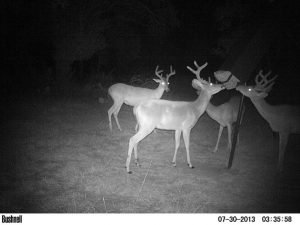 Happy summer! What a great, cool spring we had with lots of rain leaving our Texas landscape lush, green and full of activity. But as wonderful as the rain was, it might not have allowed for as much time to get out and enjoy your property. Thus, some wildlife management landowners may be finding themselves behind on their activities. Thankfully, we are just halfway through the year with plenty of summer activities and time to help you catch up.
Happy summer! What a great, cool spring we had with lots of rain leaving our Texas landscape lush, green and full of activity. But as wonderful as the rain was, it might not have allowed for as much time to get out and enjoy your property. Thus, some wildlife management landowners may be finding themselves behind on their activities. Thankfully, we are just halfway through the year with plenty of summer activities and time to help you catch up.
- Chemical Control
- MLDP Paperwork – due August 15
- Deer Surveys – start in August
- Pond Construction
- Pond Renovation and Repair
- Imported Red Fire Ant Control
- Strip Mowing – late July and August
- Half-cutting
- Supplemental Water Maintenance
- Small Mammal Surveys
Big Fish
By Damon Speidel, Wildlife Services Technician
 There are a few things in life that can dig into your soul and the mere memory excite you while simultaneously calming you down. For me, one of those is fishing. I spent some of the early years of my childhood growing up right next to a beautiful lake in upstate New York where I would constantly go fishing by myself. Being the novice I was, I can remember fishing for hours from the bank and not getting a single bite, yet I still couldn’t wait to go back and try again the following day after school.
There are a few things in life that can dig into your soul and the mere memory excite you while simultaneously calming you down. For me, one of those is fishing. I spent some of the early years of my childhood growing up right next to a beautiful lake in upstate New York where I would constantly go fishing by myself. Being the novice I was, I can remember fishing for hours from the bank and not getting a single bite, yet I still couldn’t wait to go back and try again the following day after school.
Although I was just a few hours away from the coast of the Atlantic Ocean, I never did much saltwater fishing during that time. I’ve been living in Austin for the past twenty years now and still enjoy fishing the freshwater lakes nearby. Every summer, I take a few trips to Port Aransas to breathe in some beach air, while splashing in the ocean and getting a few ultraviolet burns. Each time I go, I see people fishing right from the beach and I always tell myself that one of these times, I’m going to give it that a shot.
Just a couple weeks ago, I headed down to the coast for the weekend with my wife, April, and this time, I brought my fishing pole. Once we got into town I stopped at local market and picked up a few pounds of cooked shrimp for bait and a magazine to read. I figured if I had no luck using the shrimp as bait, then at least I could make some shrimp cocktail at the end of the day and go out with some dignity. We pulled onto the beach just at the water’s edge where there weren’t too many people, and I got right at it. I set up with a chair and put my shrimp filled cooler next to me with my magazine on top of it. I got my fishing pole, tied on a weight, and then a sharp hook. I slid on a piece of shrimp, opened the spool and made a giant hail Mary of a cast into the ocean as far as I could. I honestly wasn’t expecting much to happen and even if I did catch something, I probably wouldn’t even know what type of fish it was. Nevertheless, any fisherman will tell you that just having a fishing line in the water for a chance at something to happen is a great feeling.
It was about this time April tells me that she’s going for a walk down the beach and will see me a little later. So I sat down in my chair with my magazine and a beer in hand as my fishing pole remained propped up in the sand. About fifteen minutes went by, and I never once saw the tip of the fishing rod so much as flicker. I thought maybe the bait had been taken already, or that I should recast. I went to start reeling in and the second I did, I felt some weight, then a tug. I gave the rod a yank to set the hook and began reeling in. I could tell it wasn’t anything big, but hey, I was excited to get something. I reeled in the fish, un-hooked it, and took a photo. April was still on her walk so this memory was just for me at that moment.
I had no idea what type of fish it was and there was no one close enough I cared to bother asking, so I just let the little guy go. I put on another shrimp, gave another long cast, and sat down to resume my relaxation. Right as my back hit the chair, the fishing rod got another tug. I repeated the same steps as the first fish and reeled in another little one. Now I was getting excited as I thought maybe I had found a school of them. I quickly baited another shrimp and threw it out there. BAM! Again, another fish nailed it and I quickly reeled him in. This kept happening over and over for about an hour. I kept baiting a shrimp and no sooner than hitting the water in the same area, it would produce a fish, some were decent sized and some were small. I must have caught twenty fish in that short hour and had already gone through all my shrimp. I was having so much fun and I didn’t want to stop because when the fish are biting, no problem in the world is great enough to be remembered. Since I was out of bait, I figured I would just enjoy the rest of the time listening to the ocean.
I was quite proud of my beginner self for catching so many fish and went to grab a victory beer from the cooler. As I was about to open the cooler, I noticed the magazine pages had been blowing around from the wind and they were open to an advertisement for a restaurant in town. There were pictures of the popular menu dishes and I happened to see that one of them was grilled shrimp. I couldn’t help but remark to myself about how there was a perfect looking photo of the shrimp and I just started chuckling and thought, “What the hell. Why not? Let’s see what happens!”
If you can believe this, I carefully cut out the picture of one of the pieces of shrimp and poked the fishing hook through it on the end of my line. I really just did this for my own amusement, but it’s like playing the lottery, you never know. I gave a somewhat gentle cast so as to not have the paper rip off the hook and watched the current take it a little ways out. I was still holding my pole when it suddenly went extremely taught. I looked up in disbelief and thought, “No way! The weight probably got wedged between two rocks.” I shook the pole a little to see if I could free it, but instead got a giant yank back. My face lit up as I realized I had hooked another fish and this one felt even stronger than any I had just caught. I quickly started reeling in only to get the same amount of force pulled in the other direction. I was so excited that “happy obscenities” kept leaving my mouth and all I kept thinking was, “What kind of fish is this?! This thing feels like a monster!” My dancing around and words of excitement had drawn a few nearby people around me to come watch everything unfold. I battled this fish for a few minutes and was slowly getting it closer to shore. About this time, April was coming back from her walk and noticed that something was going on. She ran up to the small crowd and screamed, “Damon! What did you catch? Is it a shark?!!” I looked back at her and exclaimed, “I have no idea, but I bet you’ll see me in the local news tomorrow!!”
The monster was finally getting closer to shore but had never once teased me with a ferocious jump out of the water so I still had no idea what kind I had hooked. The line was coming in slightly easier now and I figured I had finally started to tire it out. I got one last giant pull from all its might and I thought that was it and the line was going to snap, but to my amazement, it didn’t. My arms and hands were getting weak but I was not about to let this fish get away. I summoned some “back up” energy I keep stored in myself for times like this and kept reeling in. Everyone’s eyes around me, including my own, were as big as grapefruits. We all couldn’t wait to catch a glimpse of this beast. I could tell I was almost done reeling in as the end of line was just under the breaking waves in front of us. The on lookers were cheering and my adrenaline was pumping. I finally got to the end as I pulled the creature out of the water and onto the sand.
Everybody and everything got extremely quiet as all our jaws dropped. No one could move or speak and it felt like the world was on mute. We all just kept looking down… and staring. For there, hooked on the end of my fishing line, was a PICTURE of a fish.
Back to TopBack to Top
Native Bees and Organic Pesticides
By Sarah N. Kahlich, AWB, Staff Biologist I

Bee pollinating an Indian blanket in Boerne, TX
The decline of honey bee populations has caught the attention of many people. Recently, it seems to have become popular to help increase honey bee population, whether it is through seeding an area with a native wildflower mix, planting flowering trees or establishing honey bee hives. Honey bees receive all the attention, while native bees are often forgotten. Native bees are responsible for pollinating approximately $3 billion worth of crops each year (Xerces Society 2012). As honey bee populations decline native bees become increasingly important in pollinating grasslands and agricultural fields. We rely on native bees to pollinate crops we need for our daily survival. There are several hundred different species of native bees that can be found in Texas. Most native bees are solitary and individual females establish and provision nest sites all on their own. Some of the more common native bees to become acquainted with are leaf-cutter bees, mason bees, mining bees, squash bees and sunflower bees. Many factors play into the decline of native bees: habitat fragmentation, excessive mowing of fields when flowers are in bloom and pesticide use.
For landowners with smaller tracts of land, pesticides are most commonly used when planting gardens. Inevitably, insects start eating our vegetables and we turn to so-called organic pesticides in the belief they are safer for us and our wildlife. However, some approved organic pesticides such as Diatomaceous Earth kill bees. These products are designed to kill invertebrates, and bees are invertebrates. The use of pesticides is not inherently bad, though it is important to be conscientious about how and when you use pesticides. Even if you are using approved organic pesticides, you need to read the label on the package to see what non-target insects it will harm or kill.
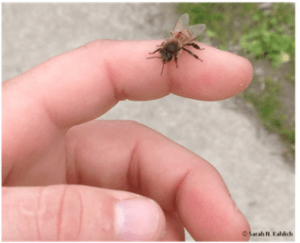
A honey bee I found on the ground during a cold afternoon. I carried it around in my cupped hand until he was warm enough to start moving around in my hand.
A honey bee I found on the ground during a cold afternoon. I carried it around in my cupped hand until he was warm enough to start moving around in my hand.
If you have to use pesticides to control insects, The Xerces Society, a non-profit organization that helps protect wildlife through the conservation of invertebrates and their habitat, has created a fact sheet, ‘Organic-Approved Pesticides: Minimizing the Risks to Bees’, that discusses pesticides and bees. Organic pesticides are broken down into insecticides, fungicides, and herbicides and rated by their toxicity to bees (non-toxic to highly toxic). Bees are poisoned when they absorb the toxins through their exoskeleton, drink tainted nectar (or in the case of honey bees tainted water), or when insecticidal dust is trapped in their pollen collecting hairs and is brought back to the hive where the colony and larvae are located. All species of bees can be harmed by pesticide use, though many guideline labels only mention the toxicity to honey bees and do not mention native bees.
Applying pesticides in a more bee-friendly manner may help reduce the impact to bees. A few factors to keep in mind when applying pesticides are: 1) Product selection, 2) Application Method, and 3) Timing of Application. When applying pesticides, choose the least toxic pesticide to be used and keep in mind the speed and direction of the wind. Reducing drift of pesticides can be controlled through calibrating the equipment and adjusting the spraying nozzle. The best application times are when crops or adjacent weeds are not in bloom or spraying later in the evening when bees are not active.
I have listed a few commonly used pesticides below. If you would like to read the fact sheet in whole it can be found here.
Boric Acid: Is a mild acid and abrasive registered for use when not in contact with food or crops. It is toxic to bees on contact, but because use is targeted for structural pests such as ants and roaches, there is usually little danger that bees will come in contact with it.
Cydia pomonella granulosis: Granulosis virus is intended to control codling moths (fruit tree pest) and has been reported as safe for honey bees (Riedl et al 2006). Threats are likely minimal to other bees as well.
Diatomaceous Earth (DE): DE is a naturally occurring chalk-like rock, that when crushed into a fine powder, it readily absorbs lipids from the waxy outer layer of insect exoskeleton causing them to dehydrate and die. Spray only when bees are not active, in the late evening or at night (Ellis and Baxendale 1997).
Garlic: This insect repellant can be applied any time with reasonable safety to bees (Riedl et al 2006). Anecdotal concerns exist about the potential for garlic to mask floral aromas and results in lower bee visitation.
Pyrethrins: These are fast-acting products derived from the pyrethrum (Chrysantehum cinerariiform) plant and acts as a broad-spectrum poison. This pesticide is extremely toxic, as little as 0.02 micrograms are sufficient to kill a bee (Caldwell et al. 2001, Cox 2002). Pyrethrins may be harmful for up to 7 days (Applied Bio-nomics, Ltd 2006).

Many honey bees collecting pollen from a Texas Thistle in Boerne, TX.
If you are opposed to using pesticides to control insects in your garden then consider ‘companion plants’ which are plants designed to deter insects. Marigolds can be planted to deter beetles from getting on asparagus. They repel Mexican beetles, beetles that eat melon plants, nematodes from eggplants and tomato worms. Zinnia planted near cauliflower will attract lady bugs, which in turn will eat most of the pests that attack cauliflower. Herbs can also be planted to deter pests. Borage planted around your tomato plants attracts more bees for pollination, and it can repel tomato worms. Basil can help deter mosquitoes, flies, and hornworms. There are even vegetables you can plant to act as a companion plant for other vegetables. For example, horseradish pairs well with potatoes as the strong smell of the horseradish deters the potato beetle. For those of you who like radishes, planting them with your spinach will help keep leaf miners from the spinach. Corn and beans are good companion plants as beans attract predatory insects which feed on leaf hopper, leaf beetles and fall armyworms which can damage your corn.
All species of bees are important for pollination, rather than focusing on only honey bees we should all be mindful that there are hundreds of native bees that need our help as well. Being more mindful of how and when we use pesticides will help all species of bees thrive in the future. By starting today, we can ensure there will be plenty of bees in the future.
Back to TopBack to Top
Plateau Summer Webinar Series
By Molly Cleveland, Marketing Associate
Join Plateau every other Wednesday for our Summer Webinar Series. See below for all of our upcoming topics and links to register. All webinars will begin at 12 pm.
June 29 – Farm to Fallow: Returning Ag & Cropland to its native state
If your land has been overgrazed and overworked, you may be wondering if Wildlife is the best option for you. Join us for a discussion on how to overcome the barriers and challenges of managing this type of land for wildlife.
July 13 – The Importance of Record Keeping & an Annual Report
One key to never having to worry about compliance is keeping good records. Learn how the pros do it and why it’s so important. We’ll show you what good documentation looks like for various wildlife activities and help provide some peace of mind that you are keeping track of what will be asked for, as well as the benefits of a quality annual report.
July 27 – Census Activity for Wildlife Management
You’re in Wildlife Management, you’re doing good work, why not find out how it’s affecting the wildlife on your land. A good census activity can do just that. Aimed at all types of species or specific to one like deer, Census counts can be great management tools and a fun compliance activity. This webinar will discuss various types of census activities, what counts and what does not, how to conduct a camera survey, census activities offered by Plateau, what you can learn from your census, and much more.
August 10 – Rangeland Ecology
An introduction to the basics of managing rangeland including plant health, animal:plant:soil interactions, and observed processes of change.
August 24 – Birding Basics
Join one of our expert birders as we discuss birding for beginners. We’ll cover choosing and using binoculars, bird identification basics, and the how, where, and when to choose the best birding locations, both on your land and in the area.
September 7 – Updating Your Wildlife Management Plan
Join us as we discuss the basics of Wildlife Management, the importance of having a Wildlife Management Plan and keeping it updated.
September 21 – Beekeeping
Did you know beekeeping qualifies as an Agricultural use enterprise in Texas open-space land appraisals? Join us as we discuss what is required to qualify for beekeeping, the costs associated with beekeeping and how to get started.
For a full list of webinars and webinar recordings visit our web page here.
Back to TopBack to Top
Ground Water
By Margaret Menicucci,Attorney at Braun & Gresham, PLLC.
The plentiful rain has soaked the grounds and filled our waterways. The Texas Water Development Board estimates that ground water provides about 59% of the state’s water supply – much of which is used for crop irrigation. The major aquifers include the extensive Ogalalla in West Texas, the rapidly flowing and recharging Edwards in central Texas, and the Carrizo-Wilcox which runs in a long band from the upper Louisana border in the east to the Mexican border in the south. Rural land can spread over the surface of multiple, major & minor, aquifers with varying access to usable water.
In Texas, ground water usage has been governed by concepts such as “the rule of capture” and “ownership in place.” The rule of capture means that, with some limitations regarding waste, a landowner can pump unlimited quantities of water from under his or her land, regardless of the impact on neighbors. Ownership in place means, the landowner owns the groundwater below the surface of his or her land as real property.
In order to protect aquifers from depletion, the Legislature has created numerous groundwater conservation districts. These “GCDs” are directed to work together to manage aquifers so that they continue to provide water wells into the future. GCDs can regulate pumping through permits and well-spacing requirements. (Note: the Edwards Aquifer Authority and the Subsidence District in Houston, have different goals and obligations than most other GCDs resulting in broader authority to regulate pumping). Court rulings in the past few years have stated that, because of the concept of ownership in place, GCD regulation could result in a taking for public use that requires adequate compensation.
The past 20 years may be viewed as the most dynamic time in Texas history relating to the law governing ground water. The future is sure to bring more clarification of landowners rights and obligations as the state manages population growth, drought, and migration to cities.
Back to TopBack to Top
Plateau Land Group Featured Listing
Capstone Ranch – True Texas Hill Country Living
 Experience the beauty, serenity and renewal of this Texas Hill Country ranch. Then, call it home. Improved and native pastures, mature Live Oaks, abundant wildlife, quintessential Hill Country main house, inviting guest house, and functional barn with equipment. Capstone Ranch will bring your dreams to reality as a homestead, recreational retreat, or investment opportunity.
Experience the beauty, serenity and renewal of this Texas Hill Country ranch. Then, call it home. Improved and native pastures, mature Live Oaks, abundant wildlife, quintessential Hill Country main house, inviting guest house, and functional barn with equipment. Capstone Ranch will bring your dreams to reality as a homestead, recreational retreat, or investment opportunity.
Capstone Ranch Open House Wine Tasting Event
Capstone Ranch invites you to an open house wine tasting before the Hye Heritage Festival!
Come experience the charming Hill Country town of Hye, located between Johnson City and Fredericksburg, this Saturday, June 25th. Join Plateau Land Group Realtor Megan Herrington at Capstone Ranch from 11am to 1pm to taste a few of Hye’s most sophisticated wines. A wine professional will be pouring and critiquing each wine, for an entertaining and educational experience all wine lovers will enjoy. The tasting is free and includes a gift bag with winery information. While you are here, explore the 186-acre ranch estate that is available for purchase.
View all of Plateau Land Group’s listings.
Back to TopBack to Top



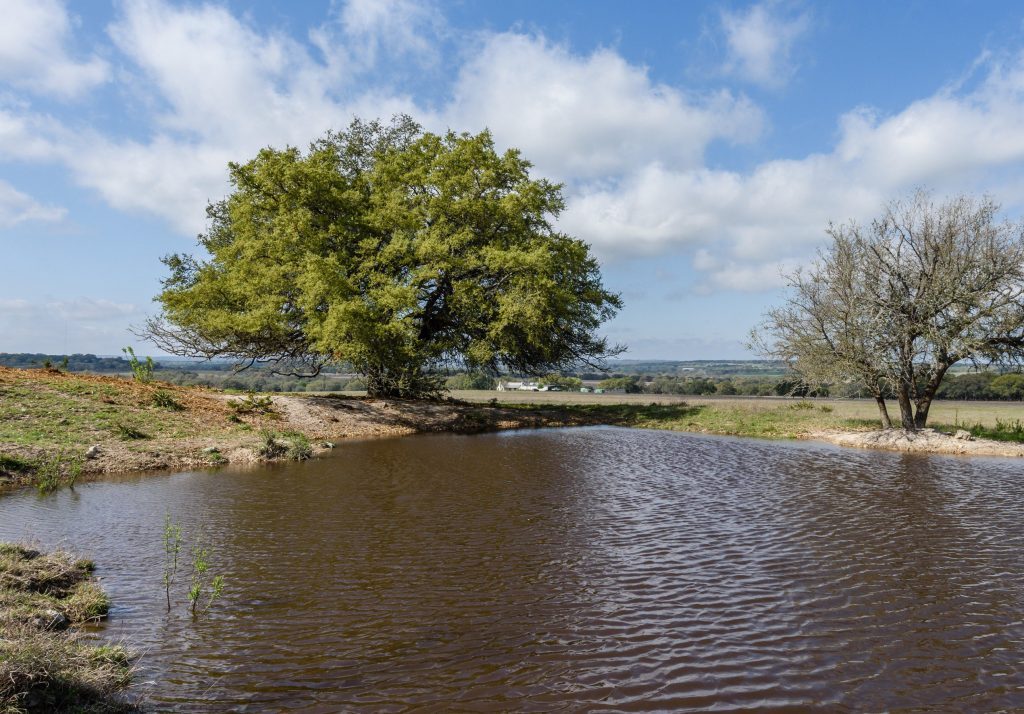



Sorry, the comment form is closed at this time.